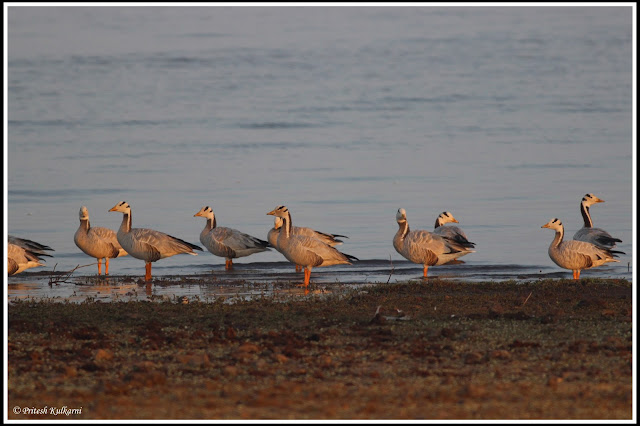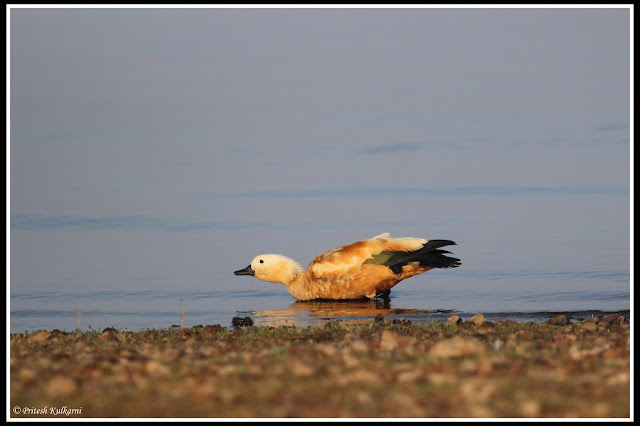I visit Bhigwan at least once a year for bird watching and this year was not an exception for my activity. I and Renuka decided to visit this place January 2017. To avoid crowd we decided to visit on weekdays. Every year, I visit Diksal village from Bhigwan. I heard a lot about Kumbhargaon village which is developed as a bird sanctuary and professional people to handle all type of tourists.
We decided to visit Kumbhargaon in the morning and sunset time at Diksal village. From last 9 years, Bharat Nagare from Diksal helping me for a boat ride. We developed good friendship bond hence Diksal visit was mandatory.
About Bhigwan Bird sanctuary:
Bhigwan, a catchment area of Ujani Dam, is about 105 km from Pune on the Pune-Solapur highway (NH 9). An area of about 18000 hectares has been proposed as a sanctuary for migratory birds. It is an amazing place to see wetland migratory birds like Bar-Headed Goose, Greater Flamingo, Ruddy Shelduck, many spices of ducks and many more birds.
To reach Diksal village (near Bhigwan), the easy way is Pune – Hadapsar – Join Solapur highway – Drive your vehicle 100km from Pune on Highway – Do not use Bhigwan flyover – Take a left at Bhigwan square on highway – Drive 3 to 3.5km – Take right for sanctuary. How to identify correct right turn is; you can spot water tank tower (yellow colored) on that T junction on the left-hand side of the road.
GPS Location for Kumbhargaon: 18.263426, 74.803876
GPS Location for Diksal: 18.295129, 74.806933
 |
| Greater Flamingo at Diksal |
Jan 2017: Bhigwan Bird sanctuary:
As we had to cover around 105-110km so we decided to leave Pune before 5 AM and we managed to leave on time. Soon we touched Solapur highway. Road condition of the highway was excellent. Due to the wide and smooth road, we were able to reach Bhigwan in less than 2 hours. We reached at Kumbhargaon first. We have informed Datta Nagare for a boat ride. Soon we took a boat ride. Electric pole-wire was occupied by Whiskered Tern.
 |
| Grey Heron after sunrise at Bhigwan |
 |
| Whiskered Terns |
We traveled towards Diksal village as all Flamingos and other birds were landed there. While going there, I got few flight photos. Soon we approached towards Flamingo. Every year I visit Diksal and my expectation was to see birding activity near Kumbhargaon. Got to know that most of the time, boats from Kumbhargaon visit Diksal for Flamingos.
 |
| Northen Shoveler Duck |
We spend around 1.5 hours watching their activity without disturbing them. By any chance, if they noticed us, they were just moving their position. A couple of times they flew away but again settled down close to our boat.
Greater flamingo is the largest species of flamingo. It is found in Africa, on the Indian subcontinent, in the Middle East and southern Europe. Average Life of Flamingo is 60 years. Greater Flamingos are pinkish white but Dark pink feathers with black feathers are covered under wings. You can see beautiful Display of pink color during their Flight. Using its feet, the bird stirs up the mud, then sucks water through its bill and filters out small shrimp, seeds and blue-green algae. Greater Flamingo can be seen in Bhigwan but Lesser Flamingo observed rarely here.
 |
| Greater Flamingo |
 |
| Glossy ibis |
 |
| Greater Flamingo in flight |
 |
| Take off flight by Greater Flamingo |
We left that place to spot other birds. We went on another side of catchment area by boat. We saw a huge group of Painted stork. We spend around an hour and watched their morning activity, sun basking etc. Besides Flamingo, we spotted Woolly Necked Stork, Coot, ibis, bar-headed goose's, Ruddy Shelduck (aka Brahmini Duck), Northern Shoveler, Garganey Duck, northern pintail and much more.
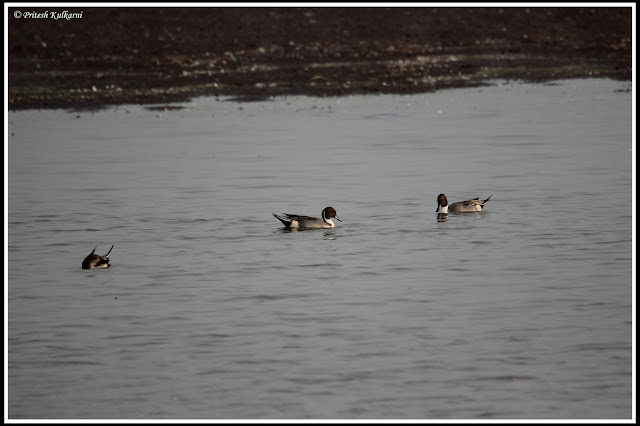 |
| Northern pintail duck at Bhigwan |
 |
| It's a Wake-up Time |
 |
| Northern shoveler Duck |
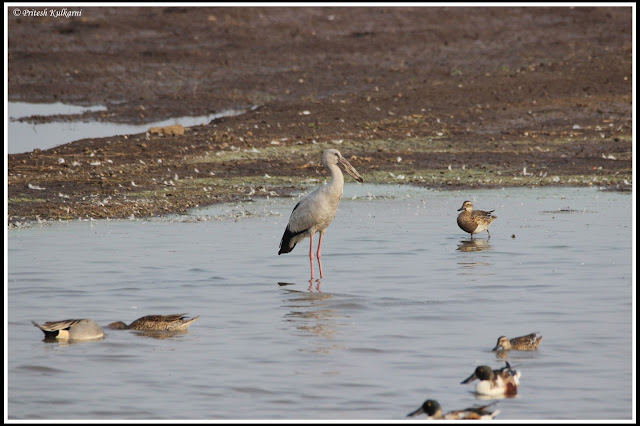 |
| Open-billed stork at Bhigwan |
 |
| ibis gang - Glossy ibis and orientail ibis |
We returned to Kumbhargaon after spending more than 2-3 hours. When we reach close to the village, we saw a small group of Comb Duck. We spend an hour to observe their activity.
 |
| Comb Duck |
 |
| Comb Duck |
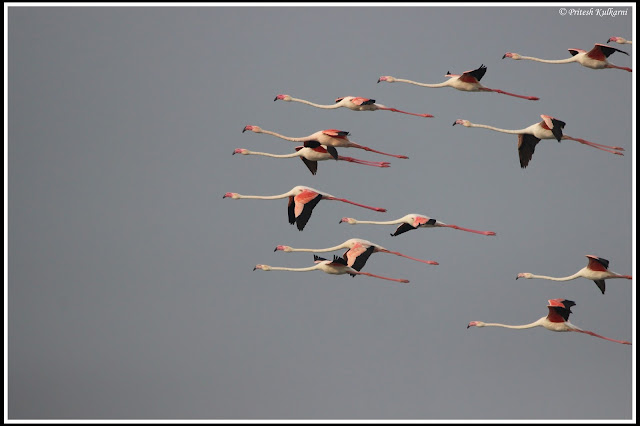 |
| Photo finish race...Greater Flamingo |
We had a small break and then left the place. We drove the car towards Baramati for few km and took an afternoon break at newly open Food mall. We had lunch and then required power nap in a car. By 3 PM, we begin our journey towards Diksal village for evening bird sighting
Our Friend, Bharat Nagare was waiting for us, Soon we board the boat and went for birding. My intention to capture Flamingo during sunset. I'm completely aware that capturing such a moments required luck. We decided to go for other birds until sunset time.
 |
| Oriental ibis |
 |
| Open Billed stork |
 |
| Northern shoveler Duck |
We saw around 5-10 Bar Headed Goose along with few Brahmin Duck busy with their breakfast and some of them were resting. We kept a safe distance and I clicked a lot of Photos. We enjoyed for an hour observing their activity. An astonishing fact about these birds is that they are one of the world's highest flying birds; they migrate over Himalayas (flying higher than 21000 ft.) to spend the winter in parts of India.
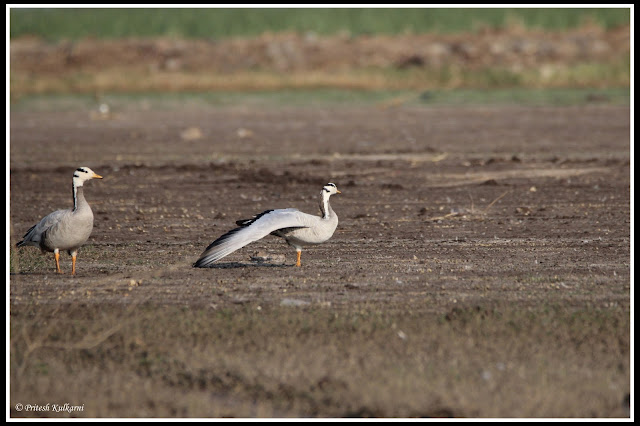 |
| Bar-headed goose yoga |
 |
| Bar-headed Goose |
 |
| Let's Fly high...Bar-headed goose |
We spot a group of Flamingo and went close to them keeping a safe distance between us. Idea is to wait till sunset and capture sunset movements. Slowly large number of Flamingo groups started gathering in front of me. I was happy as everything was going into my favor. I clicked few photographs. Just before half an hour, all of sudden all decided to take a flight and went away. I missed an opportunity to capture the beautiful sunset. In wildlife photography, experience matters a lot than the opportunity.
 |
| Greater Flamingo at Diksal |
 |
| Greater Flamingo at Diksal |
 |
| Greater Flamingo with Sunset at Diksal |
We left the Beautiful place after sunset and had dinner at my favorite restaurant hotel Kachan. we reached Pune by 8 PM safely.
 |
| Bye, Bye Diksal...Greater Flamingos |
Expenses:
- Car Petrol: INR 1000/- (Avg INR 68/Lit, Total distance cover by car was 230km)
- Toll on NH-09: INR 30/- (Return toll)
- Toll 2 on NH-09: INR 50/- (Return Toll)
- Boat ride at Kumbhargaon: INR 1000/- for boat for 2-2.30 Hrs
- Breakfast at Kumbhargaon: INR 50/- for 2 Poha
- Coffee at Kumbhargaon: INR 30/- for 1 Glass
- Lunch: INR 200-400/- for couple based on your order
- Evening boat ride at Diksal: INR 800/- for boat
- Dinner at hotel Kanchan: INR 440/- for couple
Contact number:
- Bharat (Boatman from Diksal): 9766292989.
- Datta Nagare (Boatman from Kumbhargaon ): 8087767691.
I will try to upload more and more travel blogs. Thanks for reading this Travel Blog.
Pritesh Kulkarni
Pune



























